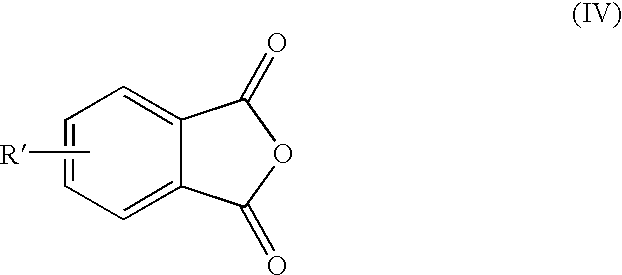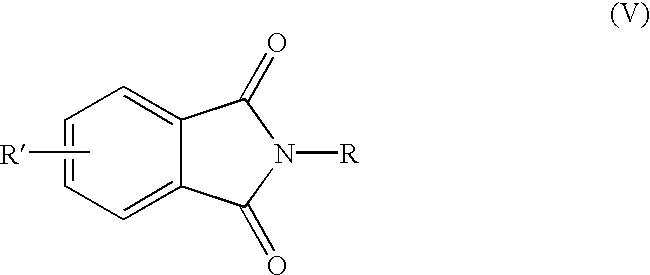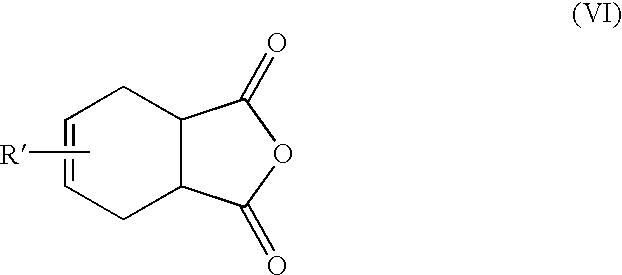Methods for the preparation of 4-chlorophthalic anhydride
a technology of phthalic anhydride and 4-chlorophthalic anhydride, which is applied in the preparation of carboxylic compounds, organic chemistry, chemistry apparatus and processes, etc., can solve the problems of low yield of 4-chlorophthalic anhydride, tar formation, and difficult separation of 4-chlorophthalic anhydride,
- Summary
- Abstract
- Description
- Claims
- Application Information
AI Technical Summary
Problems solved by technology
Method used
Image
Examples
example 1
Synthesis of N-methyl-4-chlorophthalimide (VIII).
An appropriately equipped glass reaction vessel was charged with 186.5 grams (1 mole) of 4-chlorotetrahydrophthalic anhydride and heated to 150.degree. C. under nitrogen. Methylamine gas (32 grams, 1.03 mole) was then introduced to the reaction vessel subsurface over 30 minutes. The reaction mixture was then heated for 3 hours at 180.degree. C. The product was then distilled to give N-methyl-4-chlorophthalimide in approximately 95% yield.
example 2
Synthesis of 4-Chlorotetrahydrophthalic Anhydride (IX).
156.9 g (1.6 mole) of maleic anhydride and 250 ml toluene were added to a flask. 25 ml of toluene was removed by distillation to dry the solution. 150 g (1.69 mole) of chloroprene dissolved in 250 ml of xylene was slowly added to the flask. The entire addition took 30 minutes. The resulting solution was then heated at 55.degree. C. for three hours. The solution was then distilled to remove solvents. The remaining material was distilled at 160-165.degree. C. (1 to 2 mm pressure) to afford 4-chlorotetrahydrophthalic anhydride in 85% yield (253 grams).
example 3
Synthesis of 4-Chlorophthalic Anhydride (III)
A resealable 50-ml stainless steel tube was charged with 1.5 g 4-chlorotetrahydrophthalic anhydride, 0.262 g N-methyl-4-chlorophthalimide, 0.841 g triethylamine, and 20 ml of water. The tube was sealed and heated in an oil bath at 170.degree. C. for 3 hours, and then cooled to room temperature.
A small sample of the aqueous phase was analyzed by GCMS. The analysis showed that 83.2% exchange had occurred. Analysis further showed that the reaction mixture was composed of 2.4 mol % of N-methyl-4-chlorophthalimide, 11.9 mol % of N-methyl-4-chloro tetrahydrophthalimide, 11.9 mol % of 4-chlorophthalic anhydride (as the triethylamine salt of the corresponding diacid), and 73.8 mol % of 4-chlorotetrahydrophthalic anhydride (as the triethylamine salt of the corresponding diacid).
The aqueous phase was extracted with 20 ml of toluene containing 3 wt % triethylamine in a separatory funnel at room temperature. The toluene extraction effectively. remove...
PUM
 Login to View More
Login to View More Abstract
Description
Claims
Application Information
 Login to View More
Login to View More - R&D
- Intellectual Property
- Life Sciences
- Materials
- Tech Scout
- Unparalleled Data Quality
- Higher Quality Content
- 60% Fewer Hallucinations
Browse by: Latest US Patents, China's latest patents, Technical Efficacy Thesaurus, Application Domain, Technology Topic, Popular Technical Reports.
© 2025 PatSnap. All rights reserved.Legal|Privacy policy|Modern Slavery Act Transparency Statement|Sitemap|About US| Contact US: help@patsnap.com



